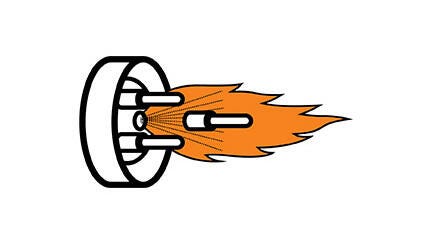
What is terminal venting?
If a compressor’s electrical terminal pin is damaged, weakened or otherwise loses its seal and separates from the compressor terminal, pressurized oil, refrigerant and debris may spray out. This is called “terminal venting.”
The ejected debris, oil, and refrigerant can injure people or damage property. The oil and refrigerant spray can be ignited by electrical arcing at the terminal or any nearby ignition source, producing flames that may project a significant distance from the compressor. The distance depends on the pressure and the amount of refrigerant and oil mixture in the system. The flames can cause serious or fatal burns and ignite nearby materials.
A variety of abnormal conditions can cause terminal venting, including internal or external electrical faults/shorts, or mechanical damage to the terminal or compressor.
How do I know if terminal venting is about to occur?
- IMMEDIATELY GET AWAY if you hear unusual sounds in the compressor. This may sound like electrical arcing (sizzling, sputtering or popping). Terminal venting may be imminent.
- However, terminal venting can occur even if you do not hear any unusual sounds. Always follow the precautions below.
What precautions should I follow during servicing to reduce the risk from terminal venting?
Never reset a breaker or replace a blown fuse without performing appropriate electrical testing
- A tripped breaker or blown fuse may indicate an electrical fault in the compressor or system. Energizing a compressor with an electrical fault can cause terminal venting. Perform checks to rule out an electrical fault before energizing the system. See the Not Starting/Running Troubleshooting Guide and the Starts/Runs Troubleshooting Guide.
Never energize the compressor unless the terminal cover or terminal plug are in place. Keep clear of the compressor when power is applied.
- Compressors have either a terminal box cover or a molded plug that covers electrical connections. The cover or plug helps to protect against electric shock and the risks of terminal venting. If terminal venting occurs, the cover or plug reduces the risk of ignition and may shield the refrigerant and oil spray. However, neither the terminal cover nor the molded plug eliminates the risk of venting, ignition, or electric shock.
- Before removing the terminal cover or molded plug, check that ALL electrical power is disconnected from the unit. Make sure that all power legs are open. (NOTE: The system may have more than one power supply.)
- Always use control of hazardous energy (lock-out/tag-out) procedures to ensure that power is not reconnected until after the terminal cover or molded plug have been replaced.
Keep all non-essential personnel away from the compressor during servicing.
Always follow all safety precautions provided by the system manufacturer.
How can I reduce the risks of terminal venting when energizing the unit after service?
Before energizing the system:
- Check the terminal connector for any wear or tear, rust, or discoloration.
- Make sure all electrical connections are tight.
- Securely fasten the protective terminal cover or molded plug to the compressor.
- Check that the compressor is properly grounded per the applicable system and compressor requirements.
- Confirm that the breaker and/or fuse size are correct for the unit.
If a compressor does not use flammable refrigerants, is there still a risk of fire or explosion?
Yes. Under the right circumstances, even non-flammable refrigerants (class A1) and oils can be ignited when they spray out of the terminal under pressure. The finely atomized spray of refrigerant and oil may ignite, even though they may be difficult to ignite otherwise. All flammable refrigerants pose an even greater fire or explosion risk if terminal venting occurs, including both A3 (flammable) and A2L (mildly flammable) refrigerants.
Copeland uses or may use in the future, the flammable refrigerant types set forth here: https://webapps.copeland.com/online-product-information/Publication/LaunchPDF?Index=AEB&PDF=93-11. The Copeland compressor models indicated at the following link are currently designed for use with various flammable refrigerants: https://webapps.copeland.com/online-product-information/. Please click on the model number to access the service manual for that compressor model, which will indicate whether a compressor model was designed for use with flammable refrigerants and the list of refrigerants specified for the compressor.
Please continue to check back for the latest safety information. Content is being updated regularly.

